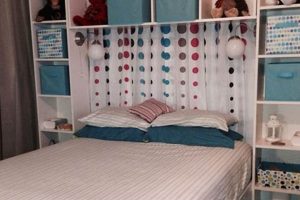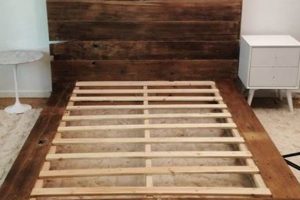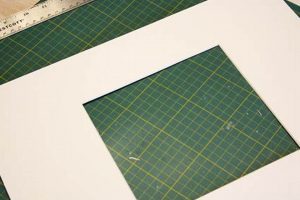A self-constructed sleeping platform, designed specifically for a twin-sized mattress, offers an alternative to commercially manufactured bed structures. Such constructions typically involve assembling lumber, metal, or other materials to create a supportive base and headboard, footboard, or side rails as desired. The dimensions are standardized to accommodate a mattress approximately 39 inches wide and 75 inches long.
Constructing a bed support system independently presents several advantages. Individuals can tailor the design to match specific aesthetic preferences, space constraints, or storage needs. This approach can also lead to cost savings compared to purchasing pre-made alternatives, particularly when utilizing repurposed or locally sourced materials. Historically, self-sufficiency in furniture creation has been a common practice, reflecting resourcefulness and the ability to customize living spaces.
The subsequent discussion will address essential considerations for such a project. These will include selecting appropriate materials, outlining fundamental construction techniques, and providing guidance on ensuring structural integrity and safety.
Essential Considerations for a Self-Built Twin Bed Support
Successfully creating a durable and aesthetically pleasing twin bed support structure necessitates careful planning and execution. The following points outline critical aspects to consider during the construction process.
Tip 1: Material Selection: Opt for kiln-dried lumber to minimize warping and ensure structural stability. Consider hardwoods like maple or oak for increased strength and longevity, or explore cost-effective alternatives like pine or fir, ensuring proper treatment and sealing.
Tip 2: Precise Measurements: Accurate measurements are paramount. Verify the dimensions of the twin mattress and account for any desired overhang or inset when planning the frame size. Double-check all measurements before cutting any materials.
Tip 3: Secure Joinery: Employ robust joinery techniques, such as mortise and tenon, dovetail, or pocket-hole joinery, to create strong and durable connections between frame components. Utilize high-quality wood glue in conjunction with mechanical fasteners for added strength.
Tip 4: Adequate Support: Incorporate sufficient center support to prevent sagging, particularly for heavier mattresses. This may involve adding additional slats or a central support beam extending the length of the frame.
Tip 5: Surface Preparation: Thoroughly sand all surfaces to eliminate splinters and create a smooth finish. Apply a sealant, stain, or paint to protect the wood and enhance its appearance. Ensure all finishes are non-toxic and suitable for indoor use.
Tip 6: Hardware Considerations: Select appropriate hardware, such as screws, bolts, and brackets, based on the material and the intended load. Use rust-resistant hardware for long-term durability.
Tip 7: Safety Inspection: Upon completion, rigorously inspect the entire structure for any sharp edges, loose fasteners, or structural weaknesses. Reinforce any areas of concern before putting the bed into service.
Adherence to these considerations will significantly increase the likelihood of constructing a safe, stable, and visually appealing twin bed support system.
The final section will summarize the key aspects of such a project and offer concluding remarks.
1. Materials
The selection of appropriate materials forms the foundational element for a successful, self-constructed twin bed support. The chosen materials directly influence the bed’s durability, structural integrity, aesthetic appeal, and overall cost-effectiveness. Careful consideration must be given to the properties of various options to ensure suitability for the intended purpose.
- Lumber Type and Grade
The type and grade of lumber employed significantly impact the bed’s strength and longevity. Hardwoods, such as maple or oak, offer superior durability and resistance to wear, making them suitable for high-stress areas. Softwoods, like pine or fir, present a more economical alternative, albeit with reduced strength and increased susceptibility to damage. Lumber grade dictates the presence of knots, imperfections, and overall quality, influencing both structural performance and visual appeal.
- Fasteners and Adhesives
The selection of appropriate fasteners, including screws, bolts, and nails, is crucial for ensuring secure connections between frame components. The fastener material, size, and type must be compatible with the chosen lumber. High-quality wood glue, compliant with relevant safety standards, complements mechanical fasteners by providing additional strength and rigidity to the assembled structure.
- Surface Treatments and Finishes
Surface treatments, such as sealants, stains, and paints, protect the lumber from moisture, UV radiation, and physical damage, extending its lifespan and maintaining its aesthetic appearance. The chosen finish must be non-toxic, durable, and compatible with the selected lumber. Consideration should be given to the finish’s impact on indoor air quality and its resistance to scratches, stains, and wear.
- Metal Components (Optional)
While predominantly a wood-based construction, metal components, such as brackets or reinforcement plates, can augment structural integrity and provide additional support. The type of metal used, typically steel or aluminum, should be selected based on its strength, corrosion resistance, and compatibility with the overall design. Proper integration of metal elements requires careful planning and execution to avoid creating stress points or compromising the aesthetic appeal.
The interplay of these material considerations directly affects the success of a self-constructed twin bed support. Informed material selection balances cost, durability, aesthetics, and safety, contributing to a long-lasting and functional piece of furniture. Ignoring these factors can lead to structural weaknesses, premature failure, and potential safety hazards.
2. Dimensions
Accurate dimensions are paramount to the successful execution of a self-constructed twin bed support. The standard dimensions of a twin mattress, typically 39 inches wide and 75 inches long, serve as the foundational constraint within which the framework must be designed. Deviations from these dimensions, even minor ones, can result in a mattress that either does not fit within the frame or fits too loosely, leading to instability and discomfort. Consider, for example, a frame built even one inch too small in either dimension: the mattress cannot be properly seated, impacting sleep quality and potentially damaging the mattress itself. Conversely, an oversized frame allows the mattress to shift, creating noise and instability.
Beyond the basic mattress size, dimensional considerations extend to the desired height of the bed frame, the thickness of the lumber used, and the inclusion of any additional features, such as a headboard or storage compartments. The height of the frame affects ease of access and can impact the overall aesthetics of the room. Lumber thickness, a key factor influencing load-bearing capacity, dictates the necessary dimensions of support structures. Integrated storage requires careful planning to ensure adequate space without compromising the structural integrity of the frame. For instance, a frame designed to sit close to the floor might need thinner lumber for the sides and base to maintain aesthetic proportions, but those dimensions must be balanced with support requirements.
In summary, the dimensional aspect of such a project is not merely a matter of following instructions; it is a critical element influencing functionality, stability, and visual appeal. Accurate measurements, careful planning, and a thorough understanding of how different dimensions interrelate are essential for achieving a satisfactory and lasting result. Failure to attend to dimensional precision ultimately undermines the time, effort, and resources invested in the construction.
3. Joinery
The structural integrity of a self-constructed twin bed support is directly contingent upon the quality of its joinery. Joinery, in this context, refers to the methods employed to connect individual pieces of lumber to form a cohesive and load-bearing framework. Inadequate joinery techniques compromise the bed’s stability, potentially leading to premature failure and posing a safety risk to the occupant. For example, using only nails to join the side rails to the headboard and footboard would result in a weak connection prone to loosening over time, especially under the weight of a mattress and occupant, ultimately causing the bed frame to collapse.
Several joinery methods are applicable to the construction of a twin bed support, each offering varying degrees of strength, complexity, and aesthetic appeal. Mortise and tenon joints, characterized by a projecting tenon fitting snugly into a corresponding mortise, provide exceptional strength and durability. Dovetail joints, interlocking wedge-shaped projections, offer superior resistance to tensile forces and are commonly employed in situations requiring high structural integrity. Pocket-hole joinery, while less visually appealing, provides a relatively simple and effective method for creating strong connections using screws inserted at an angle. The choice of joinery method should be informed by the specific design of the bed frame, the type of lumber used, and the skill level of the builder. Implementing a reinforced corner bracket along with pocket hole joinery can make it even stronger as a real life examples.
In summary, the careful selection and execution of appropriate joinery techniques are indispensable for constructing a safe, durable, and aesthetically pleasing twin bed support. Compromising on joinery quality, even in seemingly minor areas, can undermine the overall structural integrity of the bed frame and jeopardize its long-term performance. Prioritizing robust joinery methods is, therefore, a fundamental aspect of any successful project.
4. Support
Adequate support is a critical component in a self-constructed twin bed frame, directly influencing its stability, longevity, and the occupant’s comfort. Insufficient support causes mattress sagging, uneven weight distribution, and potential structural failure of the frame itself. For instance, a frame constructed with widely spaced slats provides inadequate vertical support, resulting in the mattress dipping downwards between the slats, creating discomfort and potentially shortening the mattress’s lifespan. Proper support distributes the weight evenly across the entire mattress surface, maximizing comfort and preventing premature wear.
The type and placement of support structures vary depending on the design and materials used in the bed frame. Common support methods include the use of wooden slats, solid platforms, or metal support systems. Slats, typically constructed from softwood or hardwood, are spaced at regular intervals to provide a flexible yet supportive base. Solid platforms, constructed from plywood or similar materials, offer a rigid and uniform support surface. Metal support systems, often incorporating springs or wire grids, provide a more resilient and customizable support solution. Regardless of the chosen method, the support structure must be designed to withstand the combined weight of the mattress and occupant without significant deflection or deformation. A frame intended to support two adults would need significantly more robust support elements than one intended for a child. The type of mattress is also a consideration; for example, memory foam mattresses generally require a more solid and even support structure compared to traditional innerspring mattresses.
In summary, providing adequate support is non-negotiable when constructing a twin bed frame. This involves carefully considering the load-bearing capacity of the chosen materials, selecting an appropriate support system, and ensuring proper placement and spacing of support elements. The consequences of neglecting support requirements can range from discomfort and reduced mattress lifespan to structural failure and potential injury. Therefore, meticulous attention to detail in the design and implementation of the support system is paramount for creating a safe, comfortable, and durable bed frame.
5. Finishing
The finishing stage in a self-constructed twin bed frame project extends beyond mere aesthetics; it is integral to the wood’s protection, longevity, and overall safety of the structure. Proper finishing seals the wood, preventing moisture absorption and minimizing the risk of warping, cracking, or decay. The selection of appropriate finishing materials and techniques significantly impacts the bed frame’s durability and suitability for its intended use.
- Protection Against Environmental Factors
Finishes provide a barrier against moisture, humidity, and temperature fluctuations. Water-based or oil-based sealants penetrate the wood fibers, creating a protective layer that inhibits water absorption. This protection is particularly crucial in environments with high humidity levels, where unfinished wood is prone to swelling and distortion. For example, a bed frame constructed from pine and left unfinished in a humid climate will likely develop mildew and structural weaknesses over time.
- Enhancement of Aesthetic Appeal
Finishing allows for customization of the bed frame’s appearance, enabling the builder to achieve a desired aesthetic. Stains, paints, and varnishes can be applied to alter the wood’s color, texture, and sheen. These finishes can be selected to complement the room’s decor or to highlight the natural grain of the wood. A clear varnish, for instance, enhances the wood’s natural beauty while providing a durable protective coating. Paints allow for a broader range of color options and can be used to create a more contemporary or whimsical design.
- Prevention of Splintering and Surface Damage
Sanding and sealing the wood surface eliminates sharp edges, splinters, and rough patches, reducing the risk of injury. A smooth, well-finished surface is more resistant to scratches, dents, and other forms of surface damage. This is particularly important for furniture intended for use by children, where safety is a paramount concern. Several layers of polyurethane coating over sanded wood can prevent splintering.
- Mitigation of Volatile Organic Compounds (VOCs)
The choice of finishing materials influences the level of VOCs released into the indoor environment. Selecting low-VOC or VOC-free finishes minimizes the potential for respiratory irritation and other health concerns. Water-based finishes generally contain fewer VOCs than solvent-based finishes, making them a preferable option for individuals with sensitivities or allergies. Compliance with relevant environmental regulations and safety standards is essential when selecting finishing materials. The proper ventilation is key for the VOCs release.
The finishing stage is a vital aspect of self-constructed twin bed frames. The choice of materials and techniques significantly impacts the bed frame’s durability, aesthetic appeal, safety, and environmental impact. A well-executed finish not only enhances the bed frame’s appearance but also provides long-term protection and ensures a safe and healthy sleeping environment.
6. Stability
The attribute of stability constitutes a cornerstone of any functional self-constructed twin bed frame. It directly relates to the ability of the structure to maintain its equilibrium and resist deformation under applied loads. This stability is not merely a matter of preventing the bed from collapsing; it encompasses the minimization of wobble, sway, and creaking, all of which contribute to a safe and comfortable sleeping environment. The absence of sufficient stability introduces potential hazards, including the risk of structural failure, and compromises the quality of sleep. For example, a frame constructed with inadequate cross-bracing is prone to lateral movement, particularly during movement on the mattress. This instability can lead to joint strain, material fatigue, and ultimately, a complete structural breakdown.
Achieving adequate stability in a self-built twin bed necessitates careful consideration of several key factors. These include the selection of appropriate materials, the implementation of robust joinery techniques, and the incorporation of strategically placed support elements. The use of kiln-dried lumber minimizes warping and twisting, contributing to a more stable foundation. Strong joinery, such as mortise and tenon or dovetail joints, ensures that the frame components are securely connected and resistant to separation. The addition of cross-bracing, particularly in the corners and along the sides of the frame, enhances resistance to racking forces and prevents lateral movement. Reinforcing the base with extra support in the middle of the frame improves its resistance to sagging. Moreover, the distribution of weight across the frame is critical for maintaining stability. Equal weight distribution prevents excessive stress on any single point and ensures the frame remains balanced under varying load conditions.
In conclusion, stability is not a secondary consideration but a fundamental requirement for the successful creation of a functional and safe twin bed frame. The careful selection of materials, the implementation of strong joinery, and the strategic placement of support elements are all essential for achieving the desired level of stability. Neglecting this aspect can lead to a compromised sleeping experience and potential safety hazards. Therefore, prioritizing stability throughout the design and construction process is paramount for ensuring a durable and reliable end product.
7. Safety
Safety is a paramount concern in any self-constructed twin bed frame project. The structural integrity of the bed directly impacts the well-being of its occupant, and any deficiencies in design or construction can lead to potential hazards. Cause-and-effect relationships are readily apparent: for example, using improperly sized or spaced fasteners can result in joint failure, potentially causing the bed to collapse under load. Similarly, a lack of adequate edge rounding and sanding can lead to splinters or cuts. The importance of prioritizing safety cannot be overstated; it is not merely an aesthetic or secondary consideration but a fundamental requirement for ensuring the bed is fit for its intended purpose. A bed built without concern for these elements is unsafe.
Practical applications of safety considerations are numerous. Selecting non-toxic finishes prevents the release of harmful chemicals into the sleeping environment. Employing robust joinery techniques, such as mortise and tenon or dovetail joints, ensures structural stability and prevents sudden collapse. Thoroughly inspecting the completed frame for sharp edges, protruding fasteners, or loose components mitigates the risk of injury. Real-life examples abound: instances of self-built beds collapsing due to inadequate joinery or occupants suffering injuries from sharp edges underscore the necessity of adhering to safety principles throughout the construction process. The absence of these safety features creates a real danger to the occupant.
In summary, safety is an indispensable component of the do-it-yourself twin bed frame. Prioritizing safety throughout the design, material selection, construction, and finishing stages minimizes the risk of injury, structural failure, and exposure to harmful substances. Addressing challenges such as ensuring proper structural integrity and using non-toxic materials requires careful planning and execution. The practical significance of understanding and implementing safety measures cannot be overemphasized, as it directly contributes to the well-being of the bed’s occupant and the longevity of the structure.
Frequently Asked Questions
The following questions address common concerns and misconceptions surrounding the creation of twin bed structures independently.
Question 1: Is prior carpentry experience required to construct a twin bed support structure?
While previous experience with woodworking is beneficial, it is not strictly necessary. A meticulous approach, adherence to detailed plans, and a willingness to learn basic techniques can compensate for a lack of prior experience. However, simpler designs are recommended for novice builders.
Question 2: What is the minimum set of tools required for such a project?
A basic toolkit should include a measuring tape, a saw (circular saw recommended), a drill with various bits, a sander, a level, clamps, safety glasses, and a dust mask. Additional tools, such as a router or planer, may be beneficial for more complex designs.
Question 3: How can the structural integrity of the bed frame be guaranteed?
Employ robust joinery techniques, such as mortise and tenon or dovetail joints. Ensure adequate support structures, including slats or a solid platform, are properly spaced and securely fastened. Use high-quality lumber of sufficient thickness to withstand the anticipated load. Prioritize quality and construction.
Question 4: What are the common pitfalls to avoid?
Common mistakes include inaccurate measurements, inadequate joinery, insufficient support, using low-quality lumber, neglecting safety precautions, and applying finishes improperly. Thorough planning and attention to detail are essential to avoid these pitfalls. Planning helps avoid poor decisions.
Question 5: How long does such a project typically take to complete?
The time required varies depending on the complexity of the design, the builder’s skill level, and the availability of tools and materials. A simple frame can be completed in a weekend, while more elaborate designs may require several days or weeks.
Question 6: What are the long-term maintenance requirements?
Regularly inspect the frame for loose fasteners, cracks, or other signs of damage. Tighten any loose screws or bolts. Periodically clean the frame with a damp cloth and mild detergent. Reapply finish as needed to protect the wood and maintain its appearance.
Careful consideration of these questions will facilitate a successful project. The ability to build a bed frame from scratch can be a major asset for a variety of projects.
The subsequent segment will summarize all the key points. This article gives a lot of vital information for readers.
Conclusion
The preceding exploration of “diy twin bed frame” projects has highlighted critical considerations for successful execution. Material selection, precise dimensional planning, robust joinery techniques, and adequate support systems represent fundamental elements. The importance of surface finishing and, above all, unwavering attention to safety protocols cannot be overstated. This encompasses proper construction.
Engaging in self-construction of a twin bed frame demands diligent planning and meticulous execution. The capacity to tailor the bed to specific needs and preferences offers a compelling incentive. However, prioritizing structural integrity and safety is paramount. It is incumbent upon the builder to ensure the final product adheres to the highest standards of quality and safety, thereby guaranteeing a durable and secure sleeping platform. If all of these can be ensured, the diy twin bed frame will be good to use.







